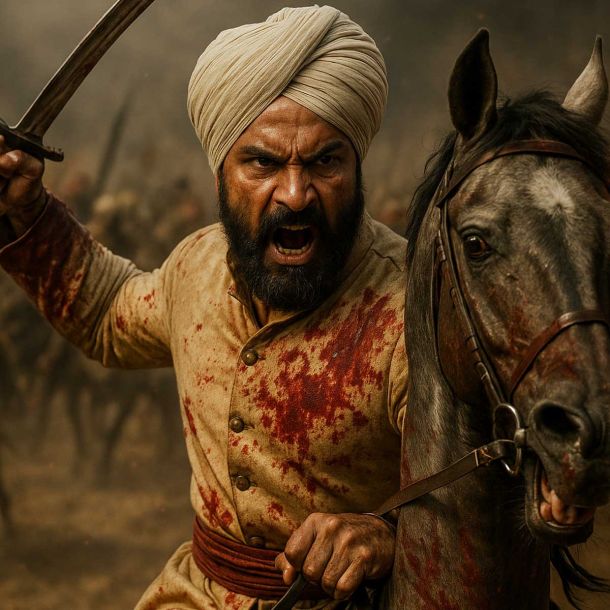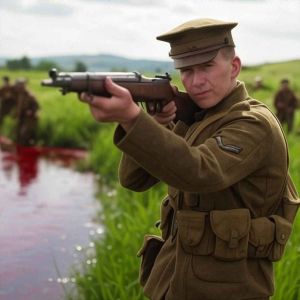Sanatan Articles
Satyaagrah
Written on
Satyaagrah
Written on
Satyaagrah
Written on
Satyaagrah
Written on
Satyaagrah
Written on
JOIN SATYAAGRAH SOCIAL MEDIA
"Victory are reserved for those warriors who are willing to pay it's price": One of the greatest and undefeated General Zorawar Singh conquered Laddakh, Tibbat,Gilgit, Skardu, Baltistan and defeated army of Imperial Chinese Tibetans in Dogra-Tibetan War

Dogra Rajput ruler Gulab Singh of Jammu appointed Zorawar his military general after being impressed by his bravery, honesty and sincerity. As the governor of Kishtwar, Zorawar extended the territories of the kingdom. He was killed in the battle of To-yo during his attempt to conquer Western Tibet - By Sri Krishna
|
Zorawar Singh Kahluria (1784-1841) known as the Napoleon of India for his conquests in the Himalayan areas, including Ladakh, Tibet, Baltistan and Skardu, was a military general of Dogra Rajput ruler Gulab Singh of Jammu. As the governor (wazir-e-wazarat) of Kishtwar, Zorawar extended the territories of the kingdom.
General Zorawar Singh also attempted the conquest of Western Tibet (Ngari Khorsum) but was killed in the battle of To-yo during the Dogra-Tibetan war.
He was born in September 1784 in a Kahluria Rajput family in the princely state of Kahlur (Bilaspur) state, in present-day Himachal Pradesh. His family migrated to the Jammu region where, on coming of age, Zorawar took up service under Raja Jaswant Singh of Marmathi (modern Doda district). Zorawar Singh was employed by the ambitious Raja Gulab Singh and was placed under the commandant of the Reasi fort (Bhimgarh fort). While delivering a routine message to Gulab Singh, Zorawar told him of the financial waste occurring in the fort administration, which impressed the Raja who appointed him the commandant of Reasi.
Commissariat officer
Later, seeing the honesty and sincerity of the General, the Raja appointed him commissariat officer of all forts north of Jammu. He was later made governor of Kishtwar and was given the title of Wazir (minister).
Even though it was a newly-conquered region, Zorawar had no trouble in maintaining the peace; many of the local Rajputs were recruited into his army.
The Rajputs of Jammu and Himachal traditionally excelled in mountain fighting; therefore, Zorawar had no trouble in crossing the mountain ranges and entering Ladakh through the source of the Suru River where his 5000 men defeated an army of local Botis
To the east of Kishtwar and Kashmir are the snow-clad mountains of the upper Himalayas — the rivers of Zanskar Gorge, Suru River and Drass originate from the melting snow of these mountains, and flow across the plateau of Ladakh into the Indus River. Several petty principalities in this region paid tributes to the Gyalpo of Ladakh (King). In 1834, one of these, the Raja of Timbus, sought Zorawar’s help against the Gyalpo. Meanwhile, the Rajput general had been wanting to expand the territory of Raja Gulab Singh — also at that time, according to the Gulabnama, Kishtwar went through a drought that caused a loss of revenue and forced Zorawar to extract money through war.
|
Mountain fighting
The Rajputs of Jammu and Himachal traditionally excelled in mountain fighting; therefore, Zorawar had no trouble in crossing the mountain ranges and entering Ladakh through the source of the Suru River where his 5000 men defeated an army of local Botis.
After moving to Kargil, Zorawar received the submission of the Ladakhis — however, Tsepal Namgyal, the Gyalpo (ruler), sent his general Banko Kahlon by a roundabout route to cut off Zorawar’s communications. The astute general doubled back to Kartse, where he sheltered his troops through the winter. In the spring of 1835, he defeated the large Ladakhi army of Banko Kahlon and marched his victorious troops towards Leh. The Gyalpo agreed to pay Rs 50,000 as war-indemnity and Rs 20,000 as an annual tribute.
Alarmed at the gains of the Dogras, Kashmir governor Mehan Singh incited the Ladakhi chieftains to revolt but Zorawar quickly marched back to the Himalayan valleys and subdued the rebels, consequently forcing the Raja of Zanskar to also pay a separate tribute to Jammu. But in 1836, Mehan Singh, who was in correspondence with the Lahore durbar, instigated the Gyalpo this time to revolt — Zorawar force-marched his army in ten days to surprise the Ladakhis and forced them to submit. He built a fort outside Leh and placed there a garrison of 300 men under Dalel Singh — the Gyalpo was deposed to an estate and a Ladakhi general, Ngorub Stanzin, was made the king. But the latter did not prove to be loyal hence the Gyalpo was restored to his throne in 1838.
|
Baltistan invasion
Muhammad Shah, the son of Skardu ruler Raja Ahmad Shah, fled to Leh and sought the help of the Gyalpo and Zorawar against his father. But some of the Ladakhi nobles allowed Ahmad Shah to imprison his son and sought his aid in a general rebellion against the Dogras. After defeating the Ladakhi rebels, Zorawar invaded Baltistan in the winter of 1839/40 adding a large contingent of Ladakhis to his army.
On their arrival, the Botis of Skardu were defeated and forced to flee. They were chased to the fort of Skardu, which was invested by Zorawar for a few days. Zorawar built a fort on the banks of the Indus where he placed a contingent of his soldiers.
One column under the Ladakhi prince, Nono Sungnam, followed the course of the Indus River to its source. Another column of 300 men, under Ghulam Khan, marched along the mountains leading up to the Kailas Range and thus south of the Indus. Zorawar himself led 3000 men along the plateau region where the vast and picturesque Pangong Lake is located. Sweeping all resistance before them, the three columns passed the Lake Manasarovar and converged at Gartok, defeating the small Tibetan force stationed there. The enemy commander fled to Taklakot but Zorawar stormed that fort on September 6, 1841. Envoys from Tibet now came to him as did agents of the Maharaja of Nepal, whose kingdom was only 15 miles from Taklakot.
Pilgrimage to Mansarovar
Zorawar and his men went on pilgrimage to Mansarovar and Mount Kailash. He had extended his communication and supply line over 450 miles of the inhospitable terrain by building small forts and pickets along the way. The fort Chi-T’ang was built near Taklakot, where Mehta Basti Ram was put in command of 500 men, with nine cannons. With the onset of winter, all the passes were blocked and roads snowed in. The supplies for the Dogra army over such a long distance failed despite Zorawar’s meticulous preparations.
As the intense cold, coupled with the rain, snow and lightning continued for weeks upon weeks, many of the soldiers lost their fingers and toes to frostbite. Others starved to death, while some burnt the wooden stock of their muskets to warm themselves. The Tibetans and their Chinese allies regrouped and advanced to fight back, bypassing the Dogra fort of Chi-T’ang. Zorawar and his men met them at the Battle of To-yo on December 12, 1841— in the early exchange of fire the Rajput general was wounded in his right shoulder but he grabbed a sword in his left hand. The Tibetan horsemen then charged the Dogra position and one of them thrust his lance in Zorawar Singh’s chest.
References:
 Support Us
Support Us
Satyagraha was born from the heart of our land, with an undying aim to unveil the true essence of Bharat. It seeks to illuminate the hidden tales of our valiant freedom fighters and the rich chronicles that haven't yet sung their complete melody in the mainstream.
While platforms like NDTV and 'The Wire' effortlessly garner funds under the banner of safeguarding democracy, we at Satyagraha walk a different path. Our strength and resonance come from you. In this journey to weave a stronger Bharat, every little contribution amplifies our voice. Let's come together, contribute as you can, and champion the true spirit of our nation.
 |  |  |
| ICICI Bank of Satyaagrah | Razorpay Bank of Satyaagrah | PayPal Bank of Satyaagrah - For International Payments |
If all above doesn't work, then try the LINK below:
Please share the article on other platforms
DISCLAIMER: The author is solely responsible for the views expressed in this article. The author carries the responsibility for citing and/or licensing of images utilized within the text. The website also frequently uses non-commercial images for representational purposes only in line with the article. We are not responsible for the authenticity of such images. If some images have a copyright issue, we request the person/entity to contact us at satyaagrahindia@gmail.com and we will take the necessary actions to resolve the issue.
Related Articles
- "Behold it is born. It is already sanctioned by the blood of martyred Indian youths": Madam Bhikhaiji Cama, the Brave lady to first hoist India’s flag on foreign Soil - Formative Years
- "A horse gallops with his lungs, perseveres with his heart, and wins with his character”: Shubhrak seeing his master in danger became uncontrollable and threw Qutubuddin on the ground, stomped his chest and head with mighty hooves killing him on the spot
- Saraswathi Rajamani, at 16, became the youngest and first female spy for INA, boldly recruited by Netaji in 1942, courageously spent two years spying on the British in Myanmar during WWII, a pivotal yet overlooked heroine in India's struggle for freedom
- A Great man Beyond Criticism - Martyrdom of Shaheed Bhagat Singh (Some Hidden Facts)
- Rani Chennamma of Keladi who fought bravely against Mughals and gave shelter to Shivaji’s son Rajaram, killed more than half of the forces of Aurangzeb's son Azamath Ara
- Letter to Shaheed Sukhdev 5th April, 1929 - Collected work of Shaheed Bhagat Singh and his Co-patriots
- Bhagat Irwin Gandhi - Martyrdom of Shaheed Bhagat Singh (Some Hidden Facts)
- Pratapgad Fort in Mahabaleshwar was completed in 1656 under the orders of the Maratha king Chhatrapati Shivaji: This fortress played a key role in the battle that would ultimately give rise to the Maratha Empire
- Taimur was attacked and defeated by 20 year old Rampyari Gurjar and her army of 40,000 women
- How Nehru's Govt helped China in conquering Tibet and let go of it's centuries old friend
- "समुद्रातळ शिवाजी": Behold mighty Kanhoji Angre, born 1669 in Harne, a fearless Maratha Navy hero ruling the Arabian Sea from Surat to Konkan with 80 ships, smashing British, Dutch, and Portuguese foes for 40 years, fortifying Vijayadurg and Alibag
- China attacked India just three years after PM Nehru reduced the defence expenditure by Rs 25 crores: Union Budget 1959
- Santi Ghosh and Suniti Choudhury: Two Teenage Freedom Fighters Assassinated British Magistrate
- "Nak-Kati-Rani": Defying Shah Jahan, Rani Karnavati of Garhwal inflicted unprecedented humiliation on the Mughal army, cutting off their noses; her invincible spirit remain unsung in mainstream history, overshadowing the grand tales of emperors
- The Eki Movement of hero Motilal Tejawat whose last wish is still waiting to be fulfilled - 100 years of Palchitaria massacre in Gujarat and its cover-up by the British govt





















